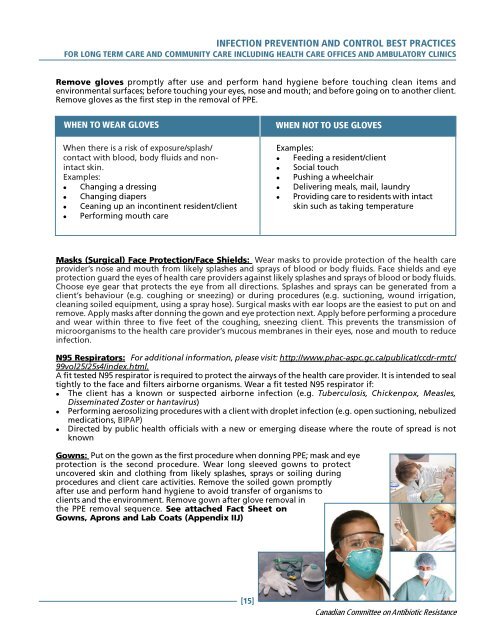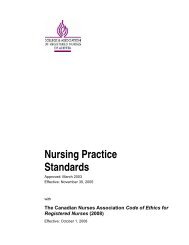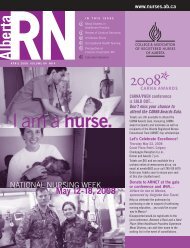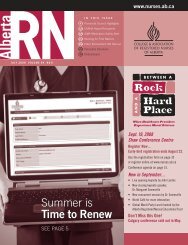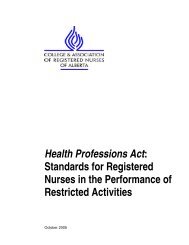Infection Prevention and Control Best Practices - College ...
Infection Prevention and Control Best Practices - College ...
Infection Prevention and Control Best Practices - College ...
Create successful ePaper yourself
Turn your PDF publications into a flip-book with our unique Google optimized e-Paper software.
INFECTION PREVENTION AND CONTROL BEST PRACTICES<br />
FOR LONG TERM CARE AND COMMUNITY CARE INCLUDING HEALTH CARE OFFICES AND AMBULATORY CLINICS<br />
Remove gloves promptly after use <strong>and</strong> perform h<strong>and</strong> hygiene before touching clean items <strong>and</strong><br />
environmental surfaces; before touching your eyes, nose <strong>and</strong> mouth; <strong>and</strong> before going on to another client.<br />
Remove gloves as the first step in the removal of PPE.<br />
WHEN TO WEAR GLOVES WHEN NOT TO USE GLOVES<br />
When there is a risk of exposure/splash/<br />
contact with blood, body fluids <strong>and</strong> nonintact<br />
skin.<br />
Examples:<br />
� Changing a dressing<br />
� Changing diapers<br />
� Ceaning up an incontinent resident/client<br />
� Performing mouth care<br />
Masks (Surgical) Face Protection/Face Shields: Wear masks to provide protection of the health care<br />
provider’s nose <strong>and</strong> mouth from likely splashes <strong>and</strong> sprays of blood or body fluids. Face shields <strong>and</strong> eye<br />
protection guard the eyes of health care providers against likely splashes <strong>and</strong> sprays of blood or body fluids.<br />
Choose eye gear that protects the eye from all directions. Splashes <strong>and</strong> sprays can be generated from a<br />
client’s behaviour (e.g. coughing or sneezing) or during procedures (e.g. suctioning, wound irrigation,<br />
cleaning soiled equipment, using a spray hose). Surgical masks with ear loops are the easiest to put on <strong>and</strong><br />
remove. Apply masks after donning the gown <strong>and</strong> eye protection next. Apply before performing a procedure<br />
<strong>and</strong> wear within three to five feet of the coughing, sneezing client. This prevents the transmission of<br />
microorganisms to the health care provider’s mucous membranes in their eyes, nose <strong>and</strong> mouth to reduce<br />
infection.<br />
N95 Respirators: For additional information, please visit: http://www.phac-aspc.gc.ca/publicat/ccdr-rmtc/<br />
99vol25/25s4/index.html.<br />
A fit tested N95 respirator is required to protect the airways of the health care provider. It is intended to seal<br />
tightly to the face <strong>and</strong> filters airborne organisms. Wear a fit tested N95 respirator if:<br />
� The client has a known or suspected airborne infection (e.g. Tuberculosis, Chickenpox, Measles,<br />
Disseminated Zoster or hantavirus)<br />
� Performing aerosolizing procedures with a client with droplet infection (e.g. open suctioning, nebulized<br />
medications, BIPAP)<br />
� Directed by public health officials with a new or emerging disease where the route of spread is not<br />
known<br />
Gowns: Put on the gown as the first procedure when donning PPE; mask <strong>and</strong> eye<br />
protection is the second procedure. Wear long sleeved gowns to protect<br />
uncovered skin <strong>and</strong> clothing from likely splashes, sprays or soiling during<br />
procedures <strong>and</strong> client care activities. Remove the soiled gown promptly<br />
after use <strong>and</strong> perform h<strong>and</strong> hygiene to avoid transfer of organisms to<br />
clients <strong>and</strong> the environment. Remove gown after glove removal in<br />
the PPE removal sequence. See attached Fact Sheet on<br />
Gowns, Aprons <strong>and</strong> Lab Coats (Appendix IIJ)<br />
[15]<br />
Examples:<br />
� Feeding a resident/client<br />
� Social touch<br />
� Pushing a wheelchair<br />
� Delivering meals, mail, laundry<br />
� Providing care to residents with intact<br />
skin such as taking temperature<br />
Canadian Committee on Antibiotic Resistance


